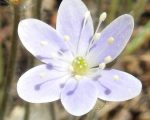 Known as one of the earliest flowers to bloom in the spring, American liverwort is a herbaceous perennial and member of the buttercup family, Ranunculaceae, that also includes columbine, hellebore, and delphinium. It is not related to true liverworts, very simple plants more closely related to mosses. American liverwort is native to hardwood forests and forest edges in Eastern North America from Ontario to the Gulf.
Known as one of the earliest flowers to bloom in the spring, American liverwort is a herbaceous perennial and member of the buttercup family, Ranunculaceae, that also includes columbine, hellebore, and delphinium. It is not related to true liverworts, very simple plants more closely related to mosses. American liverwort is native to hardwood forests and forest edges in Eastern North America from Ontario to the Gulf.
Description: Plants grow six to eight inches tall and have stems covered with silky hairs and large basal liver-shaped leaves up to three inches long with three rounded lobes. White to light blue and lavender flowers have six to ten petal-like sepals subtended by 3 hairy bracts and ½ to 1” across.
Poisonous Properties: Long contact with the plant and its juices may cause dermatitis with severe blisters. Ingestion of large amounts of the flowers or leaves may cause diarrhea, colic, and irritation of the intestinal and/or urinary tract due to the toxin protoanemonin.